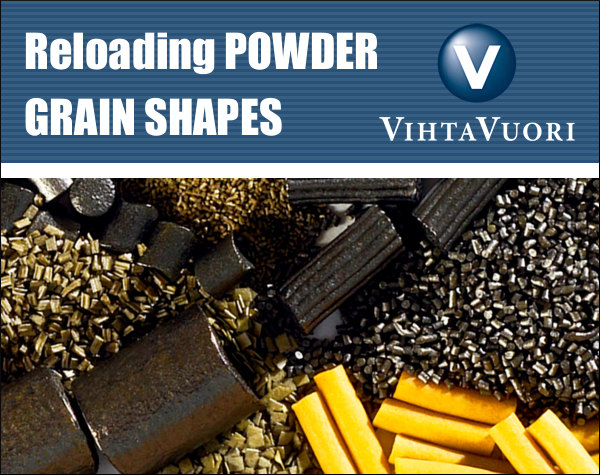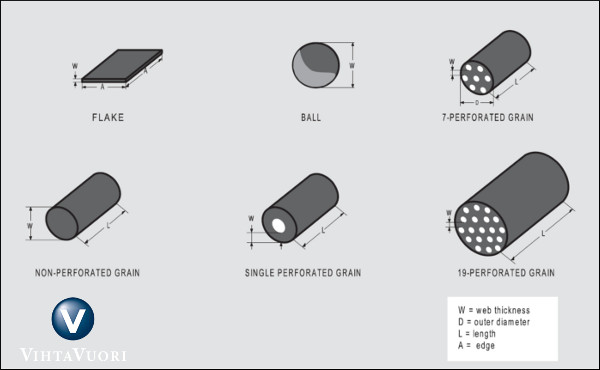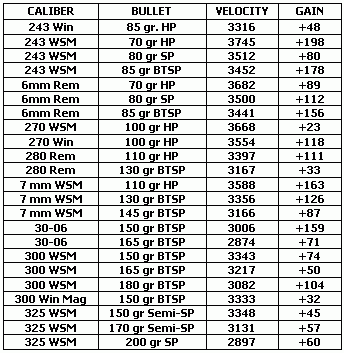|
|
April 28th, 2020

POWDER GRAIN SHAPES — What You Need to Know
The shape of powder grains has a profound effect on the performance of the powder charge, as it concerns both pressure and velocity. There are multiple powder shapes including flake, ball, and extruded or “stick” (both solid and perforated).
All Vihtavuori reloading powders are of the cylindrical, single-perforated extruded stick type. The differences in burning rate between the powders depend on the size of the grain, the wall thickness of the cylinder, the surface coating and the composition. Cylindrical extruded powders can also have multi-perforated grains. The most common types are the 7- and 19-perforated varieties. A multi-perforated powder grain is naturally of a much larger size than one with a single perforation, and is typically used for large caliber ammunition.
Other types of powder grain shapes include sphere or ball, and flake. The ball grains are typically used in automatic firearms but also in rifles and handguns. The ball grain is less costly to produce, as it is not pressed into shape like cylindrical grains. Flake shaped grains are typically used in shotgun loadings.

Web thickness in gunpowder terminology means the minimum distance that the combustion zones can travel within the powder grain without encountering each other. In spherical powders, this distance is the diameter of the “ball”; in flake powder it is the thickness of the flake; and in multi-perforated extruded powders it is the minimum distance (i.e. wall thickness) between the perforations.
The burning rate of powder composed of grains without any perforations or surface treatment is related to the surface area of the grain available for burning at any given pressure level. The change in the surface area that is burning during combustion is described by a so-called form function. If the surface area increases, the form function does likewise and its behavior is termed progressive. If the form function decreases, its behavior is said to be degressive. If the flame area remains constant throughout the combustion process, we describe it as “neutral” behavior.
The cylindrical, perforated powders are progressive; the burning rate increases as the surface area increases, and the pressure builds up slower, increasing until it reaches its peak and then collapses. Flake and ball grains are degressive; the total powder surface area and pressure are at their peak at ignition, decreasing as the combustion progresses.
So how does the shape affect pressure and muzzle velocity? In general, it can be said that powder that burns progressively achieves a desired muzzle velocity at lower maximum pressure than a powder that burns neutrally, not to mention a degressive powder. As grain size increases, the maximum pressure moves towards the muzzle, also increasing muzzle blast. Muzzle velocity and pressure can be adjusted by means of the amount of powder or loading density, i.e. the relationship between the powder mass and the volume available to it. As the loading density increases, maximum pressure grows.

This article originally appeared on the Vihtavuori Website.
September 25th, 2015

Powder Valley Inc. (PVI) is now carrying Shooters World-branded powders produced by the Czech enterprise Explosia A.S., which has produced propellants since 1920. Powder Valley will initially be offering four new Shooters World propellants: Clean Shot, Heavy Pistol, Match Rifle, and Blackout. These are canister-packaged forms of the popular Lovex propellants sold in Europe. These powders are very affordable — they cost just $19.95 per pound at PVI. For other pricing and ordering information go to PowderValleyInc.com. Match Rifle, Blackout, and Clean Shot are all currently in stock at PVI.
Shooters World says: “We have received nothing but praise about the quality of these [Lovex] propellants. Because of this, we are very confident in how our canister propellants will fare in the reloading market. We have had many competitive shooters using our product[.]”
Shooters World Reloading Guide (SAAMI) | Lovex Reloading Guide (CIP) | Burn Rate Chart
The following descriptions of Shooters World propellants have been provided by the manufacturer. Since AccurateShooter.com has not tested any of these powders yet, we cannot verify any particular claims:
Shooters World Powders — Manufacturer’s Product Descriptions
Match Rifle propellant is our canister form of Lovex D0 73-06 propellant. It is similar in burn speed to Accurate® 2520 and CFE™223. It holds the broadest utility across all moderate rifle propellants. The propellant gas generation rate is appropriate for cartridges of the light to heavy sectional density .223 Remington and .308 Winchester. It can load the 55 grain .223 Rem, as well as the 77 grain .223 Rem. It loads the 150, 168, and 175 grain .308 Winchester, and loads all .30-30 combinations. It works in .30-06, in 7mm-08, and even in the .22-250.
Blackout propellant is our canister form of Lovex D063-02 reloading propellant. It is slightly slower in burn speed than Accurate 1680®. The propellant gas generation rate is superior for subsonic 300 Blackout, 7.62×39, and some straight-walled rifle cartridges, where rapid transformation from powder to gas is desired. You would be hard pressed to find a subsonic 300 Blackout propellant that will give you the cycling reliability of the Shooters World Blackout.

Clean Shot propellant is the canister form of Lovex D0 32-03 propellant. Ballistic results for this propellant show it to be highly versatile, with low residue in a myriad of pistol cartridges. The burn rate is similar to Accurate No. 2®. Additionally, we have tested this propellant in shot shell, and found it to be exceptionally clean and consistent in velocity. This propellant can be used in virtually all pistol cartridges. A spherical propellant, it meters through charge plates extremely consistently and will work with a high-speed loader with very good flow. This propellant contains flash suppressant and is optimized for .45 ACP, 38 SPL, some standard velocity 9mm, some .40 S&W applications, reduced loads in .357 magnum, .44 magnum, and others.
Heavy Pistol propellant is our canister form of Lovex D0 37-02 propellant. It is similar in burn speed to Accurate® No. 9. The gas generation rate is appropriate for cartridges of the magnum pistol family and the .300 AAC Blackout, supersonic with light bullets. It does contain a level of flash suppression, incorporated into the propellant. A spherical propellant, it meters through charge plates consistently and will work with high-speed loaders with very good flow. This propellant is bracketed on the fast side by D0-37-01 (similar to Accurate® No 7), and on the slow side by D0-63-02 (similar in burn speed to Accurate® 1680).
CLICK HERE for Complete Explosia S.A. Catalog with many more powders.
Technical Information — CIP vs. SAAMI
Shooters World is in the process of developing reloading data based on SAAMI/ANSI standards. This data will be published on the Shooters World website, as it is generated and proofed in SAAMI test barrels, and compared against SAAMI reference ammunition. Hand-loaders can also reference information in the Lovex Reloading Guide, which has data tested to CIP (Commission Internationale Permanente) standards.
 Note that Shooters World has maintained the nomenclature of the Lovex propellants on its reloading canister bottles. Shooters World did this to ensure that reloaders would have maximum access to reloading data — both from European and American standards. Shooters World says: “The charge weights and pressures reported in the Lovex Reloading Guide have been found very reliable”. Note that Shooters World has maintained the nomenclature of the Lovex propellants on its reloading canister bottles. Shooters World did this to ensure that reloaders would have maximum access to reloading data — both from European and American standards. Shooters World says: “The charge weights and pressures reported in the Lovex Reloading Guide have been found very reliable”.
The main difference between CIP data and SAAMI standardization has to do with barrel length. CIP barrel length standards and SAAMI barrel length standards do not necessarily correspond. Therefore, the velocities reported in the Lovex Reloading Guide may not directly relate to USA standards. As is always the case, any reloader should start the load development process at a safe “starting charge”, and slowly increase charge weights to desired performance levels. Never exceed a maximum published load.
April 1st, 2014
 Here’s big (and small) news for reloaders — get ready for smaller powder containers. The U.S. Department of Transportation (DOT) recently approved new smaller containers for shipment of smokeless powder. The new containers are designed to hold 1000 grains, exactly one-seventh of a pound. That works out to 2.29 ounces of powder — quite a bit less than you are getting currently with one-pound (16 oz.) containers. Here’s big (and small) news for reloaders — get ready for smaller powder containers. The U.S. Department of Transportation (DOT) recently approved new smaller containers for shipment of smokeless powder. The new containers are designed to hold 1000 grains, exactly one-seventh of a pound. That works out to 2.29 ounces of powder — quite a bit less than you are getting currently with one-pound (16 oz.) containers.
Here how it works out:
7000 grains = 1 pound = 16 ounces
1000 grains = 0.143 pounds = 2.29 ounces
Many products — from cereal boxes to Snickers bars — have been down-sized in recent years. Now downsizing has come to the powder marketplace. The strategy behind the smaller containers is simple. In a market where demand vastly outstrips available supply, the smaller containers allow powder-makers to generate more revenue with a given amount of powder inventory. Will consumers accept the smaller powder containers? Probably so — 1000 grains is enough to load 20-22 rounds of .308 Winchester. In the current marketplace (with many powders virtually impossible to find), most consumers would probably prefer to get 2.3 ounces of their favorite powder, rather than nothing at all. (NOTE: The major powder suppliers will continue to offer popular powders in 1-lb, and 8-lb containers. The new 1000-grain containers will be phased-in over time, as an alternative to the larger containers).

Why the small bottles? One industry spokesman (who asked not to be named) explained: “We’ve had a severe shortage of smokeless powder for nearly two years. The powder production plants are running at full capacity, but there’s only so much finished product to go around. By moving to smaller containers, we can ensure that our customers at least get some powder, even if it’s not as much as they want.”
Why are the new containers 2.3 ounces rather than 8 ounces (half a pound) or 4 ounces (one-quarter pound)? One of the engineers who helped develop the new DOT-approved container explained: “We looked at various sizes. We knew we had to reduce the volume significantly to achieve our unit quantity sales goals. Some of our marketing guys liked the four-ounce option — the ‘Quarter-Pounder’. That had a nice ring to it, but ultimately we decided on the 1000 grain capacity. To the average consumer, one thousand grains sounds like a large amount of powder, even if it’s really only 2.3 ounces. This size also made it much easier to bundle the powder in six-packs. We think the six-packs will be a big hit. You get nearly a pound of powder, but you can mix and match with a variety of different propellants.”
Less Bang for Your Buck?
We’re told the new 2.3-ounce powder bottles will retail for around $8.50, i.e. about $3.70 per ounce. At that price, it may seem like you’re getting less bang for your buck. Currently, when you can find it, high-quality reloading powder typically sells for $25-$30 per pound (in 1-lb containers). At $30 per pound, you’re paying $1.88 per ounce. That means that the new mini-containers will be roughly twice as expensive, ounce-for-ounce, as current one-pounders ($3.70 per ounce vs. $1.88 per ounce).
 Why is the DOT getting involved in powder packaging? Well, powders are considered hazardous materials, subject to many rules and regulations. Before a powder manufacturer or distributor can ship any propellant, all the hazmat packaging has to be first approved by the DOT to ensure safe shipping. Why is the DOT getting involved in powder packaging? Well, powders are considered hazardous materials, subject to many rules and regulations. Before a powder manufacturer or distributor can ship any propellant, all the hazmat packaging has to be first approved by the DOT to ensure safe shipping.
Along with the 2.3-ounce containers, the DOT has approved “six-pack” consolidated delivery units that will hold six, 1000-grain containers. Some manufacturers plan to offer “variety packs” with a selection of various powders in the 1000-grain bottles. Wouldn’t it be cool to have a six-pack with H322, H4895, Varget, H4350, H4831sc, and Retumbo?
January 18th, 2009
Alliant Powder is well-known among precision shooters. Reloder 15 has set many world records in the 6BR and 6BR Improved cartridges, and the new Reloder 17 powder offers dramatically increased velocities in cartridges such as the 6XC and .284 Winchester.

At SHOT Show 2009, Alliant unveiled its new Power Pro™ series of canister, spherical powders. There are five (5) new powders: Magnum Pistol, Varmint Rifle, Medium Rifle, Large Rifle, and Magnum Rifle. Each powder has a burn rate optimized for the particular application (Medium Rifle is a bit slower than RL15, Large Rifle rate is similar to H4350, Magnum is similar to H4831). Alliant claims that “Power Pro powders deliver improved velocity and density for more efficient reloading and help reloaders duplicate certain factory loaded ammunition.” Alliant engineer Dick Quensenberry said reloaders can expect to get +50 fps more from the Power Pro series than with most other, comparable ball powders.

 New Powder for 50-Caliber Applications New Powder for 50-Caliber Applications
Alliant also recently introduced Reloder 50, a new powder designed for long-range, 50 caliber rifle shooters. Burn rate is “a little slower than Winchester 860.” The powder is showing excellent lot-to-lot consistency and the load density is optimized for the 50 BMG and similar cases. Like Reloder 17, Reloder 50 employs a process which staturates/penetrates the kernels with the burn rate controlling chemical. This should allow a longer, flatter pressure curve, allowing more velocity than conventional powders can deliver. Alliant says that Reloder 50 offers “superior velocity and the ability to burn cleaner (with less residue).” Reloder 50 will be available in both 1-lb (#150527) and 8-lb (#150528) containers.
On the Horizon — More Alliant Powders like Reloder 17
Reloder 17, made in Switzerland by Nitro Chemie, is a unique propellant that offer a smoother, longer energy release because the burn rate controlling chemicals are saturated into the kernels rather than just applied to the outside. This can provide extra energy over the course of the burn, with the result that Reloder 17 can deliver more velocity than any other powder with a similar burn rate and density. The demonstrated high performance of Reloder 17 has created demand for similar formulations, but with faster or slower burn rates. The good news is that Alliant’s Reloder 50 (see above) has the new burn rate control chemsitry, and Alliant is working right now on at least two new powders that will use the Nitro Chemie’s new powder technology. One powder (Reloder 16?) will be faster than RL 17, and one will be slower — possibly in the H1000 range. Stay tuned to AccurateShooter.com for future updates.
February 12th, 2008
 Alliant Powder, a division of Alliant Tech Systems Inc., (ATK), will be shipping new Reloder 17 powder in mid-March, 2008. This is an all-new, double-base powder produced in Switzerland by NitroChemie for Alliant. It is a high-energy powder with a burn rate close to IMR 4350, and “midway between Reloder 15 and Reloder 19.” The powder density is optimized for the short magnum cases such as the 7mm WSM and 300 WSM, but it also will work very well with cartridges such as .243 Win, .270 Win, 6XC, and 6mm Remington, according to Alliant Product Manager Dick Quesenberry. Alliant Powder, a division of Alliant Tech Systems Inc., (ATK), will be shipping new Reloder 17 powder in mid-March, 2008. This is an all-new, double-base powder produced in Switzerland by NitroChemie for Alliant. It is a high-energy powder with a burn rate close to IMR 4350, and “midway between Reloder 15 and Reloder 19.” The powder density is optimized for the short magnum cases such as the 7mm WSM and 300 WSM, but it also will work very well with cartridges such as .243 Win, .270 Win, 6XC, and 6mm Remington, according to Alliant Product Manager Dick Quesenberry.
Reloder 17, a state-of-the-art propellant, promises to deliver higher velocities than competitive powders for many popular calibers. If you have the “need for speed”, Reloder 17 is worth trying if you’re shooting IMR4350, H4350, N550 or similar powders right now. The new RL17 will be offered in 1-lb. and 5-lb. containers and will cost about the same as other Alliant Reloder powders, such as RL15 and RL19.
Mr. Quesenberry noted that Alliant tested many formulations, from a variety of makers, before choosing the Swiss-made Reloder 17. Alliant’s new RL17 is NOT the same as Norma URP, produced by Bofors in Europe. According to Alliant, the new Reloder 17 tested superior to URP (and most other powders in that burn range) in all major criteria: Velocity, Accuracy, ES/SD, material consistency, and resistance to ambient temperature-induced pressure changes.
Reloder 17 features an advanced, penetrant-type kernel coating. Alliant believes this is superior to typical surface powder coatings because it provides a more consistent, progressive burn. The powder pressures do not spike as sharply as with surface-coated powders, but remain more consistent throughout the burning process.
Testing has shown that Reloder 17 offers big velocity gains in many cartridges compared to other powders in the same burn range. For example, in the 6mm Remington, using an 85gr BTSP, Reloder 17 delivered a +156 fps gain over all other powders listed in the current Speer Reloading manual. Likewise, in the 300 WSM with a 180gr BTSP, Reloder 17 offered +104 fps edge in velocity over all powders listed in the Speer Manual. Below is a chart showing projected velocity gains compared to other Speer Manual-listed powders.
VELOCITY GAINS with RELOADER 17 POWDER

Alliant has already done extensive load testing in its ballistics laboratories and has load data available for 20 popular cartridges, including .243 Win, 6mm Rem, 6.5×55, .260 Rem, .270 Win, .308 Win, 30-06, 7mm WSM, 300 WSM, and 300 Win Magnum.
CLICK HERE for ALLIANT RELODER® 17 LOAD DATA
NOTE CONCERNING LOAD DATA:
Reloder® 17 was created with new technology to provide velocity greater than the competition in the most popular standard rifle calibers and the new short magnums. For the recipes developed in Alliant’s Ballistics Laboratory, all loads used Speer bullets and list the correct Overall Length — DO NOT SEAT THE BULLETS TO A LESS OVERALL LENGTH. These recipes are maximum loads and shall not be exceeded. Always start at least 5% low and work up.
|


















 Here’s big (and small) news for reloaders — get ready for smaller powder containers. The U.S. Department of Transportation (DOT) recently approved new smaller containers for shipment of smokeless powder. The new containers are designed to hold 1000 grains, exactly one-seventh of a pound. That works out to 2.29 ounces of powder — quite a bit less than you are getting currently with one-pound (16 oz.) containers.
Here’s big (and small) news for reloaders — get ready for smaller powder containers. The U.S. Department of Transportation (DOT) recently approved new smaller containers for shipment of smokeless powder. The new containers are designed to hold 1000 grains, exactly one-seventh of a pound. That works out to 2.29 ounces of powder — quite a bit less than you are getting currently with one-pound (16 oz.) containers.
 Why is the DOT getting involved in powder packaging? Well, powders are considered hazardous materials, subject to many rules and regulations. Before a powder manufacturer or distributor can ship any propellant, all the hazmat packaging has to be first approved by the DOT to ensure safe shipping.
Why is the DOT getting involved in powder packaging? Well, powders are considered hazardous materials, subject to many rules and regulations. Before a powder manufacturer or distributor can ship any propellant, all the hazmat packaging has to be first approved by the DOT to ensure safe shipping.

 New Powder for 50-Caliber Applications
New Powder for 50-Caliber Applications Alliant Powder, a division of Alliant Tech Systems Inc., (ATK), will be shipping new
Alliant Powder, a division of Alliant Tech Systems Inc., (ATK), will be shipping new 





